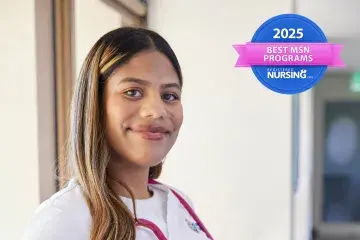Blueprint for a Nurse Anesthetist

Iman Mattox, ABSN ’18, MSN-CRNA ’23, was 10 years into a teaching career when he decided to become a certified registered nurse anesthetist (CRNA). Although he had a 2.0 GPA in college and didn’t pass a single science class, he decided to pursue one of the most rigorous nursing specialties out there. At 34, Iman quit his job as a seventh grade PE teacher, went back to school at Chabot Community College in Hayward, California, and filled his schedule with science classes. He also volunteered at Highland Hospital in Oakland, restocking supplies, transporting patients, and helping nurses with whatever they needed. It was there he learned about SMU’s Master of Science in Nursing-CRNA program.
“It was almost like reaching for the heavens,” says Iman, who used to tell his students they could be anything they set their minds to. “To be a CRNA, you have to be highly intelligent, get good grades, have good personal skills and leadership qualities. These are all the things I aspire to. I want to be that person. So, I was like, ‘I want this.’”
In 2017, Iman contacted SMU and came away with a plan to earn an Accelerated Bachelor of Science in Nursing (ABSN) degree before going on to the MSN-CRNA program. Around that same time, he got in touch with CRNA program Director Joe Janakes and Associate Director Kevin Hamby, as well as Ugochukwu Umeh, MSN-CRNA ’18, then a second year CRNA student who had come up through the ABSN program.
“They gave me a blueprint,” says Iman, who earned his ABSN degree in 2018. “I just pretty much did what they told me to do. I was hungry, and I’d do whatever I needed to do to get there.”
More Diverse Certified Registered Nurse Anesthetists
To be accepted into the MSN-CRNA program, Iman needed at least a year of nursing experience in a critical care setting. Since Bay Area intensive care units (ICUs) are notoriously competitive, even for experienced nurses, Janakes suggested he look out of state. In the end, “whatever I needed to do” included going to Wichita, Kansas to get the ICU experience he needed. He stayed in touch with Janakes and Hamby though and those relationships were a major factor in his decision to return to SMU.
“I had talked to people who said this was the hardest thing I was ever going to do,” Iman says. “So, I knew I needed to be somewhere they’re going to fully support me and to have my back with whatever I need. That’s what they do at SMU.”
The University’s CRNA program is known as a national leader for recruiting and training diverse CRNAs and, along with the mentoring, it helped Iman feel at home. As an African American man entering a specialty where only 12% of practitioners are people of color and 2% are Black or African American, Iman is helping to diversify the CRNA field in more ways than one. Early in his teaching career, he learned Spanish to connect with his Spanish speaking students, and today, his fluency comes as a welcome surprise to many of the patients he sees in his clinical rotations.
“There’s something to be said for having healthcare providers who look like you, or who speak your language. I can just see it in people’s eyes.” he says. “And if I can make them just a little more relaxed, it decreases their heart rate, blood pressure, and anxiety. Then it can even decrease the amount of sedation or anesthetic that I have to give them.”


